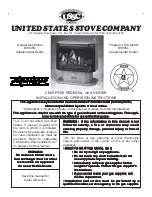
LP-389 Rev. 6.3.15
6
Have leaks fixed at once by a qualified service technician. Failure
to comply could result in substantial property damage, severe
personal injury, or death.
Operate Pressure Relief Valve
•
Before proceeding, verify that the relief valve has
been piped to a safe place of discharge, avoiding any
possibility of scalding from hot water.
To avoid water damage or scalding due to relief valve operation,
a discharge line must be connected to the valve outlet and
directed to a safe place of disposal. This discharge line must be
installed by a qualified service technician or heating/plumbing
installer in accordance with the appliance installation manual.
The discharge line must be terminated so as to eliminate
possibility of severe burns or property damage should the valve
discharge.
•
Read the temperature and pressure gauge to ensure the
system is pressurized. Minimum is 10 psi. Maximum is 25
psig for boilers, 145 psig for VWH models. Lift the relief
valve top lever slightly, allowing water to relieve through
the valve and discharge piping.
• If water flows freely, release the lever and allow the valve
to seat. Watch the end of the relief valve discharge pipe to
ensure that the valve does not weep after the line has had
hard time to drain. If the valve weeps, lift the lever again
to attempt to clean the valve seat. If the valve does not
properly seat and continues to weep, contact a qualified
service technician to inspect the valve and system.
• If water does not flow from the valve when you completely
lift the lever, the valve or discharge line may be blocked.
Immediately shut the appliance down per instructions on
page 2 and call a qualified service technician to inspect
the valve and system.

























